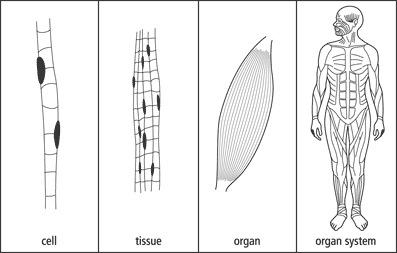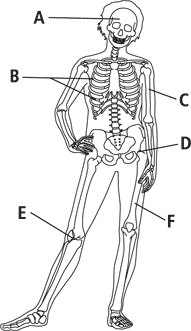| A | B |
|---|
| The process of respiration allows the body to obtain | sugars |
| ____________, a type of involuntary muscle, is found inside some organs and performs automatic movements. | smooth muscle |
| Skeletal muscles can move bones because the muscles are attached to the bones by tissues called ____________ . | tendons |
| Your ____________ is made up of all the muscles in your body. | muscular system |
| The muscle that makes up your heart is called ____________. | cardiac muscle |
| Your muscles affect your ____________ by helping you stand up straight. | posture |
| A skeletal muscle is called a ____________ because you can control the way it moves. | voluntary muscle |
| Shivering is one way your muscles help you maintain your ____________. | body temperature |
| providing support and protection is a function of what system? | skeletal |
| The shoulder is part of which part of the skeletal syste? | appendicular |
| The hips are part of which part of the skeletal syste? | appendicular |
| The arms are part of which part of the skeletal system? | appendicular |
| The legs are part of which part of the skeletal system? | appendicular |
| The cranium is part of which part of the skeletal system? | axial |
| The spine is part of which part of the skeletal system? | axial |
| The ribs are part of which part of the skeletal system? | axial |
| The lightweight tissue found inside bone is called | spongy |
| Compact bone tissue functions to | provide support to body |
| For an organ system to function properly, the organs that make up the system must | work together |
| The function of nerve tissue is to | carry electrical impulses through the body |
| The ability of your body to maintain internal conditions such as temperature is | homeostasis |
| A collection of two or more types of tissue that work together to perform a specific function is called a(n) | organ |
Which of the following are not contained within an organ: organ system, cell, tissue?,  | organ system |
Which of the labeled structures are parts of the skeletal system?,  | A-F, or all of the labeled structures |
Which organ system is pictured here?,  | muscular system |
| What is the simplest level of organization in the body? | cell |
| What makes up an organ? | tissue |
Which structure is a ball-and-socket joint?,  | D |
Where in structure C are red blood cells formed?,  | spongy bone - marrow |
Structures A and B are both parts of which main division of the skeleton?,  | axial |
Which of the labeled bones contain both compact and spongy bone tissue?,  | All of the labeled bones contain both types of bone tissue. |
What type of joint makes up most of the joints in structure A?,  | immovable joint |
What is the purpose of the organ system pictured here?,  | The muscular System |
What makes up organs?,  | cell and tissue |
What makes up organs systems?,  | cells, tissues, and organs |
During which period in a human's life does structure C stop growing?,  | adolescence |
Does structure F contain spongy bone tissue? Explain.,  | Yes, structure F is a bone and all bones contain spongy bone tissue. |
Look at structure A. What function do the bones in this structure perform?,  | protect the brain |
The axial skeleton is the major division of the skeleton that runs from top to bottom. Which letter(s) indicate(s) a structure in the axial skeleton?,  | A and B |
Which letter(s) indicate(s) a joint?,  | D and E |
Which body system is pictured here?,  | skeletal |
| What is the function of the kidneys? | concentration of water in body |
| Kidneys remove excess water from the body. What is this maintaining? | homeostasis |
| Approximately how often does your body's supply of blood move through your kidneys? | many times a day |
| Dialysis is a process that helps people whose kidneys no longer function properly. Given what you know about kidneys, what does dialysis do? | removes toxins and waste from the blood |
| Which body system removes water vapor and waste gases from the body's blood? | respiratory system |
| Peristalsis contributes to | mechanical digestion |
| Digestion provides energy to your body by breaking down food into usable materials such as | carbohydrates |
| Which of the following are used to release energy during cellular respiration? | glucose and oxygen |
| What function of the respiratory system is shown by steamy breath in cold weather? | water removal |
| What would happen if your epiglottis failed to function properly? | air would enter your stomach |
| What is a function of the respiratory system? | obtaining oxygen and removing liquid wastes from the blood |
| Which describes the order in which waste products travel through the urinary system? | kidneys, ureters, bladder, urethra |
| What is one way that kidneys help maintain the homeostasis of cells? | They regulate the amount of water in the body. |
| What may happen to the body if its kidneys are not functioning properly? | Wastes build up in the bloodstream. |
| Which body system removes the solid waste that is left from food? | digestive system |
| Which of the following actions is a form of chemical digestion? | softening food with saliva in your mouth |
| How does the digestive system function to provide energy for the body? | It breaks down foods that supply energy to the body. |
| In your cells, oxygen and sugars are used to release energy in a process called | cellular respiration |
| The respiratory system helps you produce sounds when | air moves over your vocal cords |
| What muscle action is responsible for expanding the thoracic cavity before air enters the lungs? | contraction of the diaphragm muscle |
| What is the function of the respiratory system? | It obtains oxygen for the body. |
| The organ that helps maintain homeostasis by controlling the amount of water in your urine is called the | kidney |
| The urinary system removes wastes from | blood |
| The kidneys are a part of the | urinary system |
| Which organ uses sweat gland to remove waste from the body? | skin |
| Oxygen passes from your alveoli into your blood in your | lungs |
| Chewing food into smaller pieces with your teeth is a form of | mechanical digestion |
| The digestive system breaks down foods, which supply necessary | energy and materials |
| The body system that functions to produce speech is the | respiratory |
| During cellular respiration, your cells use oxygen and sugars to release | energy |